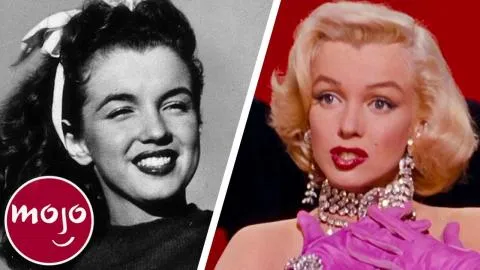The Tragic Life of Marilyn Monroe

For this video, we’re examining the history of Hollywood’s most famous starlet, whose life was over much too soon.
It won’t be surprising to learn that “Marilyn Monroe” wasn’t the name she was born with; her given name was Norma Jeane Baker, and she was born and raised in Los Angeles, California, always with the shadow of Hollywood looming over her. For the earliest years of her life she was raised by her mentally ill mother, Gladys, and though the identity of her father has been speculated, even she never knew for certain who he was, and he never attempted to be a part of her life. By all accounts, Monroe’s time spent with her mother was not happy, and when Gladys had a breakdown and received a diagnosis of paranoid schizophrenia – poorly understood in the 1930s – Monroe was taken into foster care. She spent the next ten years of her life shuffled around various foster homes and families and became incredibly shy after she was abused by her caregivers. Aged sixteen, she married a sailor and became a housewife, never finishing high school.
It was during the Second World War that Monroe got her big break. As part of the war effort she went to work at a factory and met a photographer, David Conover, who was taking morale-boosting pictures of women at work. After this, she began doing modeling work and was signed to an agency, dyeing her hair blonde and changing her name to “Marilyn Monroe” to be more appealing. “Marilyn” came from Marilyn Miller, a Broadway star big in the 1920s, who was only 37 when she died – a year older than Monroe herself at the time of her death – while “Monroe” was her mother’s maiden name. Despite maintaining this connection with her mother, who was institutionalized by this point, Monroe’s agent made her pretend her mother was dead.
By 1946, she’d signed to 20th Century Fox, though they didn’t think much of her at first; she didn’t get one role in the first six months of her contract and spent her days learning about acting rather than actually doing any. Eventually though, the studios realized they had someone special on their hands and Monroe quickly proved to be a hit at the box office. Six years of hard work later, she’d built up to receiving top billing, starring alongside Jane Russell in the classic “Gentlemen Prefer Blondes” which, along with their other starring roles, earned both of them stars on the Hollywood Walk of Fame.
However, Monroe was famously typecast as a “dumb blonde”, and the studios had such strict control over her public image that people began to believe she was like that in real life. In actual fact, Monroe was very intelligent; she had a large library, held her own against the studios, and tried to shed the “dumb blonde” image near the end of her life by fighting for more dramatic roles and doing serious interviews. She was also friends with renowned jazz singer Ella Fitzgerald, helping her book shows at the glitzy Mocambo club in West Hollywood when the owner initially refused. Fitzgerald said that Monroe was “ahead of her time” and didn’t even know it.
Despite achieving fame in the early ‘50s, she was already suffering psychologically at this point, and her acting mentor Lee Strasberg encouraged her to attend psychotherapy. She had many existing mental health problems like depression and anxiety, intensified by the life of a movie star and the pressure she was under; these problems were made worse by substance abuse issues. She was married numerous times, including to big names like baseball icon Joe DiMaggio and famed playwright Arthur Miller; and though she purportedly maintained a friendship with DiMaggio until the end of her life, all her marriages ended prematurely. She also suffered from endometriosis, a physical condition that causes uterine tissue to grow outside of the uterus and on other parts of the female reproductive organs; endometriosis is incredibly painful, and it led to every pregnancy she ever conceived ending in a miscarriage.
As Monroe’s career went on, she began to earn a reputation for being difficult to work with, frequently turning up late to set and intoxicated. She was prescribed many different medications, including the barbiturates which she ultimately overdosed on in August 1962, found dead in her home in Los Angeles by her housekeeper. But even in death Monroe hasn’t known peace, as conspiracies have swirled around whether she died accidentally, committed suicide, or was even murdered.
From being used in Andy Warhol artwork and beyond, Monroe has remained one of the most famous and recognizable people in history and a legend of cinema, despite her messy life. Her reputation and legacy is finally beginning to escape the “dumb blonde” cliché Hollywood so successfully manufactured, even if her image remains a profitable commodity. Hugh Hefner was interred next to Monroe after his death in 2017, despite the fact that in 1953 the very first issue of “Playboy” published nude photos of Monroe from her modeling years, without her permission. And x-rays of Monroe have also been sold at auction, with many news outlets publishing them and running with the story that they prove she had plastic surgery.
Despite the sad story of her life and death, she was nonetheless a world-famous actress who performed admirably in beloved and iconic movies, and continues to inspire.
